About the Ruta de la Pasa, the Raisin route
The raisin route through Malaga’s Axarquía takes in some beautiful and typically Moorish villages. The small whitewashed villages feel a million miles away from the more bustling Costa.
The "Ruta de la Pasa," the raisin route is the name given to a 62.5kms long road that joins up some of Malaga’s more traditional villages. All are situated in the south-western part of the Axarquía about 20 minutes east of the centre of Malaga.
The circular journey begins in Rincon de la Victoria and traverses the villages of Moclinejo, Almáchar, El Borge,Cútar, Comares and Totalán before dropping back down onto La Cala del Moral, an area of Rincon de la Victoria.
As the name suggests, the villages along the raisin route are known for their sweet Moscatel grapes. The grapes from this area are used predominantly to make sun-dried raisins and the sweet moscatel wine that Malaga is famous for.
There are over 3000 hectares of planted vineyards in the Axarquía. The landscape is dotted with beds (known as Paseros) for sun drying the hand picked grapes. The grape vineyards are interspaced with almond trees, avocado and the citrus fruits that are typical of this part of Andalusia.
All of the villages en-route are worth stopping off in and exploring further.
Here are some suggestions for what to see and do in each of them.
Moclinejo
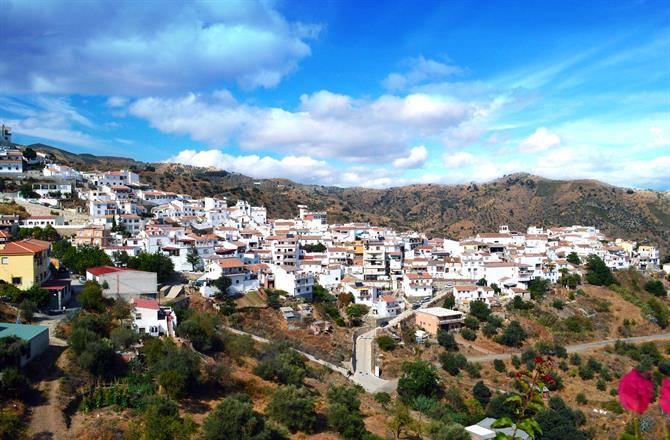
The small white-washed village of Moclinejo is perched on top of the Piedras Blancas mountain and offers spectacular views down to the coast. It is known as the ‘Gateway to Raisin country,’ Moclinejo is the starting point for our journey.
The Plaza de España is the most attractive part of Moclinejo. As with many small villages, the main square is also the focal point for all social activity within the village. The spacious open area is the meeting place for local residents. The Plaza de España is also home to Moclinejo’s most important buildings, the town hall and the Church of Nuestra Señora de Gracia, which was constructed between the 16th and 17th centuries.
Things to see - Moclinejo’s two most important natural landmarks are situated just outside of the village. The first is called Manchon de las Minas where old silver mines can be found. The mines have long since been closed after extensive flooding, but were said to contain large silver deposits at one point.
The nearby hilltop known as La Hoya de los Muertos, or sometimes as the Cuesta de Matanza, got its name after a particularly bloody battle that was fought between the Moors and Christians. In 1483, Mulay Hacen was dethroned in Granada and took refuge in the castle. The Christians attempted to dislodge him from his hilltop fortress. The Moors fought back ferociously and decimated the Christian troops. A symbolic victory for Mulay Hacen.
Local fiestas - The people of Moclinejo are known for their unique way of celebrating Christmas Day. They arm themselves with guns, both old and new and plenty of fireworks. The aim is to make as much noise as possible.
The feria in honour of the town’s patron saint, San Bartolomé, takes place at the end of August. Starting with fireworks in the morning and culminating with a procession of San Bartolomé through the streets takes place at night.
Places to eat - Restaurante Reyes, Plaza de España, 9. Tel. 952400558. Specialises in tapas. Bar Tres Penique, Plaza de España, 13. tel. 952400502 freshly cooked local dishes and daily menus. House speciality is meatballs in almond sauce. Bar Alciras, Calle Malaga, the place for local wines and coffee.
Almáchar
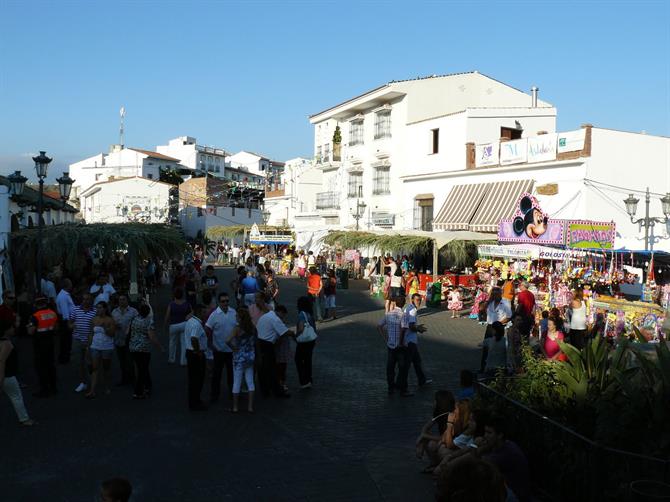
Almáchar is another village with a distinctly Arabic feel. The name Almáchar comes from the Arabic word "machar", which means meadow. Being situated between two rivers, the surrounding farmland is particularly fertile. With gentle rolling hills of vineyards, orange and lemon trees, olive groves and fields of cereals.
Wandering through its narrow, winding streets, past the whitewashed and flower adjourned houses is a joy to behold. One street to look out for is Calle de Los Mártires. Situated in the heart of the old town, its a particularly beautiful street and home to Almáchar's Church, the Parroquia San Mateo. The church dates from the 16th century and is built in the late Gothic and Renaissance style.
Above all else,Almáchar is known as the home of Ajoblanco. The cold, almond, garlic and olive oil soup. The village also produces a Denominación de Origen D.O local wine.
Things to see - The Museo de la Pasa, the Raisin museum is situated on Plaza del Santo Cristo, 5; tel. 9525120 02, located in the heart of the old town and distributed across two floors, the museum provides a unique collection of traditional tools and a carefully preserved interior that will take you back in time and show how grape production was carried out.
The main square, the Plaza del Pueblo offers some spectacular views over neighbouring El Borge. The Jardines de El Forte, the Barrio de las Cabras, the Cueva del Toro (the Bull's Cave) and the nearby town’s main fountain, where legend has it that the Moors buried their treasure before being expelled to the Alpujaras are also of note.
Local fiestas - The Dia de Ajoblanco which falls on September 2nd is the most important event and was recently designated a Festival of Tourist Interest in Andalucía. Thousands of visitors descend on Almáchar to try free samples of the local wine, moscatel grapes and, of course, gallons of Ajoblanco. For more information on the Ajoblanco feria.
Celebrations for Almáchar town’s patron saint, Nuestra Señora de Amparo take place from July 29th to 31st, with plenty of music (traditional verdiales), dancing and sporting events. The festival in honour of Santo Cristo de la Banda Verde is on the first week-end in May. Another important date on Almáchar's calendar is May 15th with the Romería de San Isidro.
Places to eat - Mesón Punto Europa, calle Cornellá, tel. 952519519. All local specialities and tapas. Venta Zapata, Carretera Almachar-El Borge km 0,8, tel. 667326454 known for its tapas. Bar El Llano, Carretera Almáchar-El Borge km 1, tel. 952519466 known for its stuffed potato dishes.
El Borge
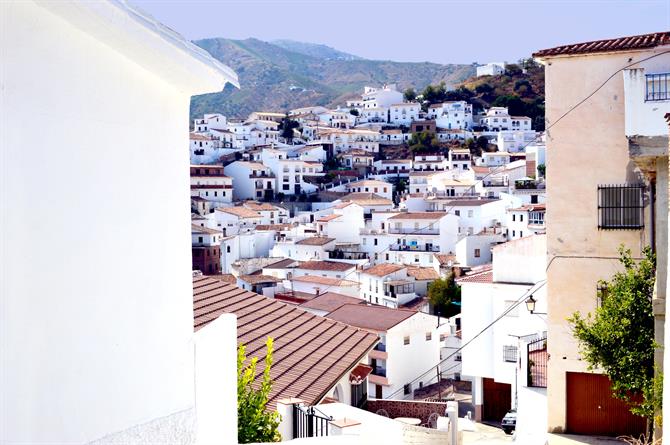
There is no mistaking that El Borge is most definitely raisin country. Its most distinctive landmark is the Arco de la Pasa (The Raisin Arch) which you need to go through upon entering the village.
El Borge is known as the ‘Raisin capital’ of the Axarquía and remains today one of the largest producers of Moscatel grapes in Malaga. The surrounding countryside is awash with paseros used for sun-drying the grapes into raisins.
The age-old steep windy streets of the village are a joy to explore with small hidden squares and flower filled balconies. The El Rinconcillo section of the village is particularly picturesque (and steep).
Things to see - The 16th Century Nuestro Senora del Rosario church is the most prominent landmark. It was built over the former Mosque and offers an interesting combination of gothic and renaissance influences. The Fuente del Cuerno (Fountain of the horn) is another important landmark.
The Arabic fountain is situated in the centre of the village and named after the goat’s horn that adjourns its construction. A much loved local landmark that has never run dry and proved to be a lifesaver for the local people during periods of droughts. The La Alcua, ornithological and botanical gardens is also of note. The small botanical park offers a selection of plants and flowers that are endemic to the area and different types of birds such as ducks, geese, swans and even ostriches.
El Borge’s most renowned resident was the bandit ‘El Bizco de El Borge,’ a giant of a man who was born cross-eyed (from which he names derives). He was one of Malaga’s most feared and respected bandits. His birthplace in the village has been converted into a small hotel and museum dedicated to banditry, the Casa natal de ‘El Bizco de El Borge.’
Local fiestas - the biggest date on the calendar is September 24th with the ‘Dia de la Pasa,’ raisin day. Thousands of visitors flock to El Borge to drink the local wines, sample the grapes and enjoy the local specialities, which include two types of gazpacho, one made with broad beans and one with cucumber.
Homage is paid to El Borge’s patron Saint Gabriel on Easter’s day and ends with a procession to the Camposanto. Another popular festival is the Sanmarqueo, unique to El Borge which takes place on April 25th.
Places to eat - Restaurante Pepe, Plaza de la Constitucion, 2. Specialises in tapas. Posada del Bandolero, calle Cristo, 1. Local dishes including ajoblanco, tortilla de bacalao con miel de caña (cod tortillas with honey) and, of course, plenty of local wine. Bar Paquillo, calle Guillermo Perez, 5. The place to try the local sweet wines.
Cútar
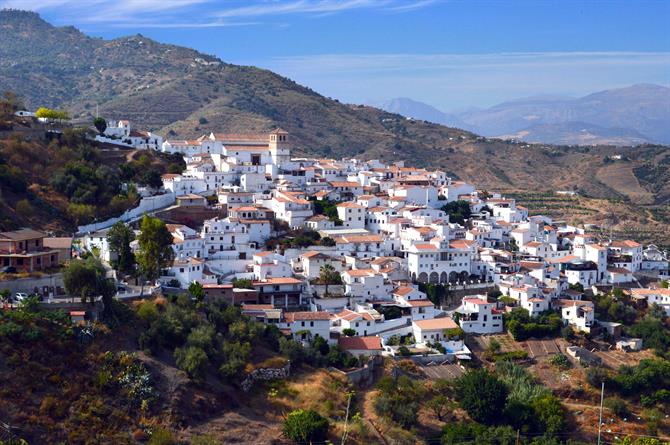
The sleeping village of Cútar is home to some 700 residents and sits at approximately 600m above sea level.
The name Cútar most probably comes from the Arabic ‘Kautzar,’ which means “fountain of paradise.” Fittingly enough, Cútar is home to the area’s last remaining and best preserved fountain that dates from Moorish times, the Fuente Aina Alcaharia.
Things to see - Salto de Negro is a small picturesque hamlet that is only two kilometres from Benamargosa, but falls within Cútar's boundaries. The area is exceptional green and tropical, with numerous citrus and avocado plantations in the immediate vicinity. There’s a fantastic walk to Salto de Negro from Comares, following the Benamargosa river.
Another interesting local landmark is the Peña del Hierro. A smallish mountain at 585 metres above sea level. Traces of the presence of prehistoric man from the Neolithic to the Bronze Ages have been found at Peña del Hierro. Roman coins, Arabic ceramics and prehistoric tools are often uncovered in Cútar.
The Nuestra Señora de la Encarnación church is the village’s most predominate landmark and situated in the Barrio Alto area. The tower from the 16th Century Mudejar style church is clearly visible from all points of the village.
Local fiestas - there are two main dates to note in Cútar's yearly calendar. The Fiesta del Monfi takes place over a weekend in October. With the village celebrating its Moorish past. The whole of Cútar is turned into one huge Medina, an Arabic themed market. There are numerous stalls offering a wide selection of medieval-themed culinary produce, Arabic sweets, aromatic herbs and plants. The residents play their part by dressing up in Medieval and Moorish themed dress, with plenty of dancing and re-enactments of key historical local events.Cútar's local Feria - La Feria de Cútar - takes place around mid-August. It pays homage to San Roque.
Places to eat - Restaurante Cútar, Calle Fuente s/n. Most house specialities have a heavy Moorish influence and include Ajoblanco (a cold almond soup served with peeled grapes), maimones soup (a garlic, olive oil and bread soup) and tortas de leche (milk cakes).
Comares
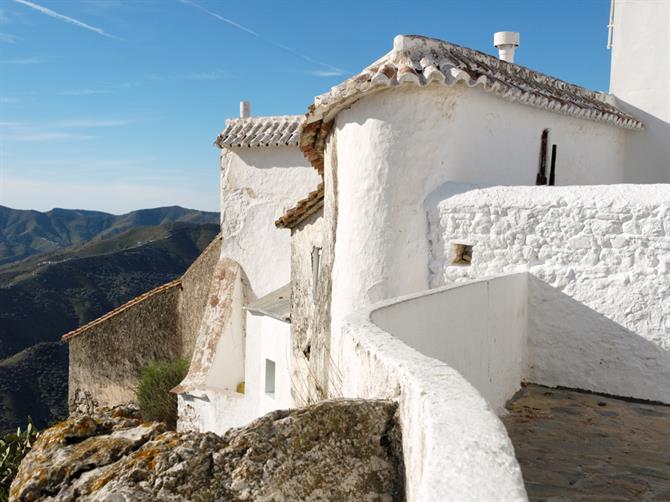
The highest village in the Axarquía. The views don’t get much better than from Comares. It was one of the most important Moorish bastions, with the ruins of a large castle still clearly visible today.
Comares is an exceptionally beautiful place to visit. The Moorish influence is omnipresent. Wandering its small and narrow, whitewashed streets, history seems to come alive at every corner. There is a street named ‘Perdon’ pardon - named after the last thirty Moors that were baptised here. An event that is still remembered every Sunday after mass and on local holidays, with the church bells ringing 30 times in their honour.
Things to see - Comares was home to one of the three principal Moorish castles in the Axarquía,headquarters of Omar Ben Hafsun. It is known locally as the Tahona and was built over an old Roman military post.
The ‘Meseta de Mazmullar,’ was declared a National Monument of Historical-Artistic interest in 1931 and sits approximately 2kms from the town centre. You can find the the remains of streets and houses and an old water reservoir built by the Moors. The sixteenth century Mudájar Church of Nuestra Senora de la Encarnacion sits at the highest point of Comares and is worth a visit.
The whole of the historical centre of Comares is a museum and richly steeped in history. Visiting it couldn't be easier, there are ceramic footsteps that are placed in the walls and pavements, you just follow the footsteps - all eventually lead back to the main Plaza (square) that is the central hive of activity in the village.
Local fiestas - In August, the Feria de las Cuevas takes place with plenty of races (horse, motorbike and bicycle), football matches and musical events. On the 7th of September, Comares celebrates the Noche de las Candelas with a particular emphasis on local verdiales. The San Hilario de Poitiers, a homeage to Comares’s patron Saint is celebrated on the 14th of January.
Places to eat - El Molino de los Abuelos, Balcon de la Axarquía, 2 - tel. 952509309, local specialities and offers some fantastic views. Bar-restaurant La Plaza, Plaza Generalisimo, 3 - tel. 952509298 house speciality is goat in sauce. Bar-Restaurante Ortega, La Loma, 4 - tel. 952115333 known for its lamb dishes.
Totalán
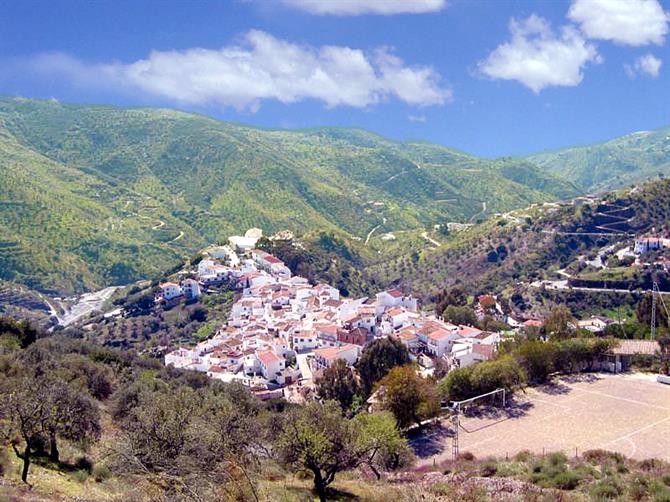
Totalán is perched on top of hillside and is known for the two lush valleys that run either side of it. When it rains in Malaga, Totalán is awash with water. There are often waterfalls and a very fast flowing river - the Arroyo de Totalán. Spring is a particularly beautiful time to visit.
Things to see - the Santa Ana Church (Iglesia parroquial de Santa Ana) is the most important building in the village. The church is known for its red marble columns, that legend has it, are all that is left over from an ancient Roman civilisation that used live here.
Recently discovered and only 600m from the village centre is a burial plot - La estructura funeraria del Cerro de la Corona - that dates from IV and III BC. Human remains and ceramics are regularly found and point to some very ancient civilizations.
Local fiestas - take place towards the end of May. The harvest, the beginnings of summer and the local processions all take place at the same time.
Places to eat - Bar Arriba y Abajo, Plaza Antonio Molino, s/n. Tapas, local dishes and sweet wines. Meson Los Naranjos, Avenida Andalucia, s/n - tel. 952400286 local specialities and daily menus. Bar Casa Pepin, Avenida Andalucia s/n - tel. 952400237, pork specialities and tapas.
